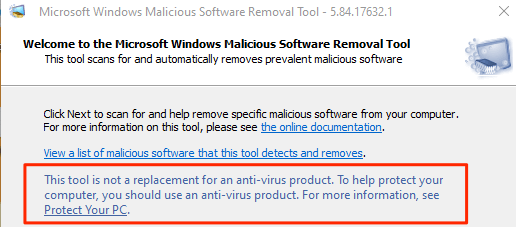
- Uninstall malicious software removal tool windows 10 how to#
- Uninstall malicious software removal tool windows 10 install#
- Uninstall malicious software removal tool windows 10 update#
- Uninstall malicious software removal tool windows 10 windows 10#
You can also perform an online scan of your computer using the Windows Live OneCare safety scanner. You should also use up-to-date antivirus software to help protect your computer from other malicious software.
Uninstall malicious software removal tool windows 10 install#
If you would like to run this tool more than once a month, use the version on this Web page or install the version that is available in the Download Center.īecause computers can appear to function normally when infected, Microsoft advises you to run this tool even if your computer seems to be fine.
Uninstall malicious software removal tool windows 10 update#
Note The version of the tool delivered by Microsoft Update and Windows Update runs in the background and then reports if an infection is found.

The tool is available from Microsoft Update, Windows Update and the Microsoft Download Center. Microsoft releases an updated version of this tool on the second Tuesday of each month, and as needed to respond to security incidents. When the detection and removal process is complete, the tool displays a report describing the outcome, including which, if any, malicious software was detected and removed.
Uninstall malicious software removal tool windows 10 windows 10#
You can download it here: Download Winaero Tweaker.The Microsoft Windows Malicious Software Removal Tool checks computers running Windows 10, Windows 8, Windows XP, Windows 2000, and Windows Server 2003 for infections by specific, prevalent malicious software-including Blaster, Sasser, and Mydoom-and helps remove any infection found. Malicious Removal Tool (MRT) Blocked by System Administrator - posted in Windows 10 Support: My Daughters personal new Dell laptop has started running extremely slow, so I ran Webroot. The Microsoft Windows Malicious Software Removal Tool helps remove malicious software from your computers that are running Windows 10, Windows 8.1, Windows Server 2012 R2, Windows 8, Windows Server 2012, Windows 7, Windows Vista, Windows Server 2008. You can save your time and use Winaero Tweaker instead.

Open an elevated command prompt and run the following command: wusa /uninstall /kb:890830 /quiet /norestart If you had Microsoft Malicious Software Removal Tool installed in Windows 10, you can easily uninstall it now. You can save your time and download ready-to-use Registry files. Note: Even if you are running a 64-bit Windows version, you still need to create the 32-bit DWORD value.
Uninstall malicious software removal tool windows 10 how to#
Tip: How to jump to the desired registry key with one click. If you do not have this Registry key, then just create it.

Once you apply the Registry tweak, the application won't be offered via Windows Update so it should not even get downloaded. Windows 10 includes the Malicious Software Removal Tool (MSRT), which is an application that Microsoft updates regularly to find and remove known threats that may cause your computer to crash or perform other unwanted tasks.

There is a Registry tweak which prevents Microsoft Malicious Software Removal Tool from being offered on Windows Update and getting installed to C:\Windows\system32\mrt.exe. This tool is known to take a long time to complete scans and consumes system resources during those scans, so you might want to prevent Windows 10 from installing it. Microsoft generally releases MSRT monthly as part of Windows Update or as the standalone tool. The application can also be downloaded separately from Microsoft's website. Windows Malicious Software Removal Tool (MSRT) 5.97 helps remove malicious software from computers running Windows11, Windows 10, Windows 8.1, Windows Server 2012 R2, Windows 8, Windows Server 2012, Windows 7, or Windows Server 2008. The Windows Malicious Software Removal Tool (MRT) is a freeware app that Microsoft redistributes via the Windows Update service. RECOMMENDED: Click here to fix Windows issues and optimize system performance


 0 kommentar(er)
0 kommentar(er)
